High Five theme by Tom O’Dea
Download: HighFive.p3t
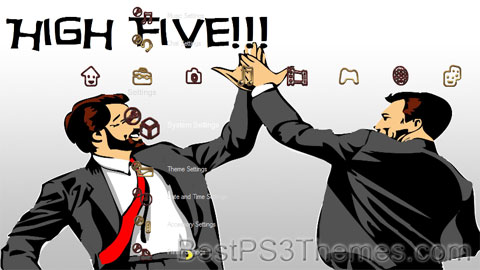
(1 background)
Redirect to:
This page is a redirect. The following categories are used to track and monitor this redirect:
|

The #1 spot for Playstation themes!
High Five theme by Tom O’Dea
Download: HighFive.p3t

(1 background)
Redirect to:
This page is a redirect. The following categories are used to track and monitor this redirect:
|
Superman theme by Tez
Download: Superman_3.p3t
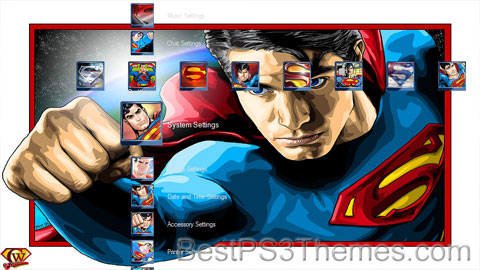
(11 backgrounds)
| Clark Kent / Kal-El Superman | |
|---|---|
 | |
| Publication information | |
| Publisher | DC Comics |
| First appearance | Action Comics #1 (cover-dated June 1938; published April 18, 1938) |
| Created by | Jerry Siegel (writer) Joe Shuster (artist) |
| In-story information | |
| Alter ego | Kal-El (birth name) Clark J. Kent (adopted name) |
| Species | Kryptonian |
| Place of origin | Krypton |
| Team affiliations | |
| Partnerships |
|
| Notable aliases |
|
| Abilities |
|
Superman is a superhero who appears in American comic books published by DC Comics. The character was created by writer Jerry Siegel and artist Joe Shuster, and debuted in the comic book Action Comics #1 (cover-dated June 1938 and published April 18, 1938).[1] Superman has been adapted to a number of other media, which includes radio serials, novels, films, television shows, theater, and video games.
Superman was born on the fictional planet Krypton with the birth name of Kal-El. As a baby, his parents sent him to Earth in a small spaceship shortly before Krypton was destroyed in a natural cataclysm. His ship landed in the American countryside near the fictional town of Smallville, Kansas. He was found and adopted by farmers Jonathan and Martha Kent, who named him Clark Kent. Clark began developing various superhuman abilities, such as incredible strength and impervious skin. His adoptive parents advised him to use his powers for the benefit of humanity, and he decided to fight crime as a vigilante. To protect his personal life, he changes into a colorful costume and uses the alias "Superman" when fighting crime. Clark resides in the fictional American city of Metropolis, where he works as a journalist for the Daily Planet. Superman's supporting characters include his love interest and fellow journalist Lois Lane, Daily Planet photographer Jimmy Olsen, and editor-in-chief Perry White, and his enemies include Brainiac, General Zod, and archenemy Lex Luthor.
Superman is the archetype of the superhero: he wears an outlandish costume, uses a codename, and fights evil with the aid of extraordinary abilities. Although there are earlier characters who arguably fit this definition, it was Superman who popularized the superhero genre and established its conventions. He was the best-selling superhero in American comic books up until the 1980s.[2]
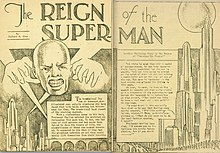
Jerry Siegel and Joe Shuster met in 1932 while attending Glenville High School in Cleveland and bonded over their admiration of fiction. Siegel aspired to become a writer and Shuster aspired to become an illustrator. Siegel wrote amateur science fiction stories, which he self-published as a magazine called Science Fiction: The Advance Guard of Future Civilization. His friend Shuster often provided illustrations for his work.[3] In January 1933, Siegel published a short story in his magazine titled "The Reign of the Superman". The titular character is a homeless man named Bill Dunn who is tricked by an evil scientist into consuming an experimental drug. The drug gives Dunn the powers of mind-reading, mind-control, and clairvoyance. He uses these powers maliciously for profit and amusement, but then the drug wears off, leaving him a powerless vagrant again. Shuster provided illustrations, depicting Dunn as a bald man.[4]
Siegel and Shuster shifted to making comic strips, with a focus on adventure and comedy. They wanted to become syndicated newspaper strip authors, so they showed their ideas to various newspaper editors. However, the newspaper editors told them that their ideas were insufficiently sensational. If they wanted to make a successful comic strip, it had to be something more sensational than anything else on the market. This prompted Siegel to revisit Superman as a comic strip character.[5][6] Siegel modified Superman's powers to make him even more sensational: Like Bill Dunn, the second prototype of Superman is given powers against his will by an unscrupulous scientist, but instead of psychic abilities, he acquires superhuman strength and bullet-proof skin.[7][8] Additionally, this new Superman was a crime-fighting hero instead of a villain, because Siegel noted that comic strips with heroic protagonists tended to be more successful.[9] In later years, Siegel once recalled that this Superman wore a "bat-like" cape in some panels, but typically he and Shuster agreed there was no costume yet, and there is none apparent in the surviving artwork.[10][11]
Siegel and Shuster showed this second concept of Superman to Consolidated Book Publishers, based in Chicago.[12][a] In May 1933, Consolidated had published a proto-comic book titled Detective Dan: Secret Operative 48.[13] It contained all-original stories as opposed to reprints of newspaper strips, which was a novelty at the time.[14] Siegel and Shuster put together a comic book in a similar format called The Superman. A delegation from Consolidated visited Cleveland that summer on a business trip and Siegel and Shuster took the opportunity to present their work in person.[15][16] Although Consolidated expressed interest, they later pulled out of the comics business without ever offering a book deal because the sales of Detective Dan were disappointing.[17][18]
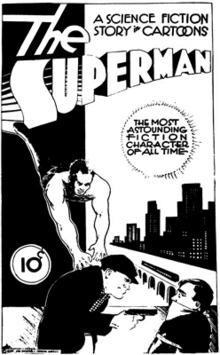
Siegel believed publishers kept rejecting them because he and Shuster were young and unknown, so he looked for an established artist to replace Shuster.[19] When Siegel told Shuster what he was doing, Shuster reacted by burning their rejected Superman comic, sparing only the cover. They continued collaborating on other projects, but for the time being Shuster was through with Superman.[20]
Siegel wrote to numerous artists.[19] The first response came in July 1933 from Leo O'Mealia, who drew the Fu Manchu strip for the Bell Syndicate.[21][22] In the script that Siegel sent to O'Mealia, Superman's origin story changes: He is a "scientist-adventurer" from the far future when humanity has naturally evolved "superpowers". Just before the Earth explodes, he escapes in a time-machine to the modern era, whereupon he immediately begins using his superpowers to fight crime.[23] O'Mealia produced a few strips and showed them to his newspaper syndicate, but they were rejected. O'Mealia did not send to Siegel any copies of his strips, and they have been lost.[24]
In June 1934, Siegel found another partner: an artist in Chicago named Russell Keaton.[25][26] Keaton drew the Buck Rogers and Skyroads comic strips. In the script that Siegel sent Keaton in June, Superman's origin story further evolved: In the distant future, when Earth is on the verge of exploding due to "giant cataclysms", the last surviving man sends his three-year-old son back in time to the year 1935. The time-machine appears on a road where it is discovered by motorists Sam and Molly Kent. They leave the boy in an orphanage, but the staff struggle to control him because he has superhuman strength and impenetrable skin. The Kents adopt the boy and name him Clark, and teach him that he must use his fantastic natural gifts for the benefit of humanity. In November, Siegel sent Keaton an extension of his script: an adventure where Superman foils a conspiracy to kidnap a star football player. The extended script mentions that Clark puts on a special "uniform" when assuming the identity of Superman, but it is not described.[27] Keaton produced two weeks' worth of strips based on Siegel's script. In November, Keaton showed his strips to a newspaper syndicate, but they too were rejected, and he abandoned the project.[28][29]
Siegel and Shuster reconciled and resumed developing Superman together. The character became an alien from the planet Krypton. Shuster designed the now-familiar costume: tights with an "S" on the chest, over-shorts, and a cape.[30][31][32] They made Clark Kent a journalist who pretends to be timid, and conceived his colleague Lois Lane, who is attracted to the bold and mighty Superman but does not realize that he and Kent are the same person.[33]

In June 1935 Siegel and Shuster finally found work with National Allied Publications, a comic magazine publishing company in New York owned by Malcolm Wheeler-Nicholson.[35] Wheeler-Nicholson published two of their strips in New Fun Comics #6 (1935): "Henri Duval" and "Doctor Occult".[36] Siegel and Shuster also showed him Superman and asked him to market Superman to the newspapers on their behalf.[37] In October, Wheeler-Nicholson offered to publish Superman in one of his own magazines.[38] Siegel and Shuster refused his offer because Wheeler-Nicholson had demonstrated himself to be an irresponsible businessman. He had been slow to respond to their letters and had not paid them for their work in New Fun Comics #6. They chose to keep marketing Superman to newspaper syndicates themselves.[39][40] Despite the erratic pay, Siegel and Shuster kept working for Wheeler-Nicholson because he was the only publisher who was buying their work, and over the years they produced other adventure strips for his magazines.[41]
Wheeler-Nicholson's financial difficulties continued to mount. In 1936, he formed a joint corporation with Harry Donenfeld and Jack Liebowitz called Detective Comics, Inc. in order to release his third magazine, which was titled Detective Comics. Siegel and Shuster produced stories for Detective Comics too, such as "Slam Bradley". Wheeler-Nicholson fell into deep debt to Donenfeld and Liebowitz, and in early January 1938, Donenfeld and Liebowitz petitioned Wheeler-Nicholson's company into bankruptcy and seized it.[3][42]
In early December 1937, Siegel visited Liebowitz in New York, and Liebowitz asked Siegel to produce some comics for an upcoming comic anthology magazine called Action Comics.[43][44] Siegel proposed some new stories, but not Superman. Siegel and Shuster were, at the time, negotiating a deal with the McClure Newspaper Syndicate for Superman. In early January 1938, Siegel had a three-way telephone conversation with Liebowitz and an employee of McClure named Max Gaines. Gaines informed Siegel that McClure had rejected Superman, and asked if he could forward their Superman strips to Liebowitz so that Liebowitz could consider them for Action Comics. Siegel agreed.[45] Liebowitz and his colleagues were impressed by the strips, and they asked Siegel and Shuster to develop the strips into 13 pages for Action Comics.[46] Having grown tired of rejections, Siegel and Shuster accepted the offer. At least now they would see Superman published.[47][48] Siegel and Shuster submitted their work in late February and were paid $130 (equivalent to $2,814 in 2023) for their work ($10 per page).[49] In early March they signed a contract at Liebowitz's request in which they gave away the copyright for Superman to Detective Comics, Inc. This was normal practice in the business, and Siegel and Shuster had given away the copyrights to their previous works as well.[50]
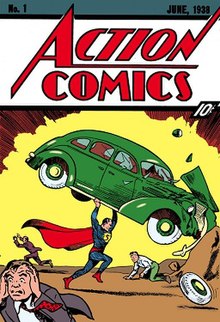
The duo's revised version of Superman appeared in the first issue of Action Comics, which was published on April 18, 1938. The issue was a huge success thanks to Superman's feature.[1][51][52]
Siegel and Shuster read pulp science-fiction and adventure magazines, and many stories featured characters with fantastical abilities such as telepathy, clairvoyance, and superhuman strength. One character in particular was John Carter of Mars from the novels by Edgar Rice Burroughs. John Carter is a human who is transported to Mars, where the lower gravity makes him stronger than the natives and allows him to leap great distances.[53][54] Another influence was Philip Wylie's 1930 novel Gladiator, featuring a protagonist named Hugo Danner who had similar powers.[55][56]
Superman's stance and devil-may-care attitude were influenced by the characters of Douglas Fairbanks, who starred in adventure films such as The Mark of Zorro and Robin Hood.[57] The name of Superman's home city, Metropolis, was taken from the 1927 film of the same name.[58] Popeye cartoons were also an influence.[58]
Clark Kent's harmless facade and dual identity were inspired by the protagonists of such movies as Don Diego de la Vega in The Mark of Zorro and Sir Percy Blakeney in The Scarlet Pimpernel. Siegel thought this would make for interesting dramatic contrast and good humor.[59][60] Another inspiration was slapstick comedian Harold Lloyd. The archetypal Lloyd character was a mild-mannered man who finds himself abused by bullies but later in the story snaps and fights back furiously.[61]
Kent is a journalist because Siegel often imagined himself becoming one after leaving school. The love triangle between Lois Lane, Clark, and Superman was inspired by Siegel's own awkwardness with girls.[62]
The pair collected comic strips in their youth, with a favorite being Winsor McCay's fantastical Little Nemo.[58] Shuster remarked on the artists who played an important part in the development of his own style: "Alex Raymond and Burne Hogarth were my idols – also Milt Caniff, Hal Foster, and Roy Crane."[58] Shuster taught himself to draw by tracing over the art in the strips and magazines they collected.[3]
As a boy, Shuster was interested in fitness culture[63] and a fan of strongmen such as Siegmund Breitbart and Joseph Greenstein. He collected fitness magazines and manuals and used their photographs as visual references for his art.[3]
The visual design of Superman came from multiple influences. The tight-fitting suit and shorts were inspired by the costumes of wrestlers, boxers, and strongmen. In early concept art, Shuster gave Superman laced sandals like those of strongmen and classical heroes, but these were eventually changed to red boots.[34] The costumes of Douglas Fairbanks were also an influence.[64] The emblem on his chest was inspired by heraldic crests.[65] Many pulp action heroes such as swashbucklers wore capes. Superman's face was based on Johnny Weissmuller with touches derived from the comic-strip character Dick Tracy and from the work of cartoonist Roy Crane.[66]
The word "superman" was commonly used in the 1920s and 1930s to describe men of great ability, most often athletes and politicians.[67] It occasionally appeared in pulp fiction stories as well, such as "The Superman of Dr. Jukes".[68] It is unclear whether Siegel and Shuster were influenced by Friedrich Nietzsche's concept of the Übermensch; they never acknowledged as much.[69]
Since 1938, Superman stories have been regularly published in periodical comic books published by DC Comics. The first and oldest of these is Action Comics, which began in April 1938.[1] Action Comics was initially an anthology magazine, but it eventually became dedicated to Superman stories. The second oldest periodical is Superman, which began in June 1939. Action Comics and Superman have been published without interruption (ignoring changes to the title and numbering scheme).[71][72] A number of other shorter-lived Superman periodicals have been published over the years.[73] Superman is part of the DC Universe, which is a shared setting of superhero characters owned by DC Comics, and consequently he frequently appears in stories alongside the likes of Batman, Wonder Woman, and others.
Superman has sold more comic books over his publication history than any other American superhero character.[74] Exact sales figures for the early decades of Superman comic books are hard to find because, like most publishers at the time, DC Comics concealed this data from its competitors and thereby the general public as well, but given the general market trends at the time, sales of Action Comics and Superman probably peaked in the mid-1940s and thereafter steadily declined.[75] Sales data first became public in 1960, and showed that Superman was the best-selling comic book character of the 1960s and 1970s.[2][76][77] Sales rose again starting in 1987. Superman #75 (Nov 1992) sold over 23 million copies,[78] making it the best-selling issue of a comic book of all time, thanks to a media sensation over the supposedly permanent death of the character in that issue.[79] Sales declined from that point on. In March 2018, Action Comics sold just 51,534 copies, although such low figures are normal for superhero comic books in general (for comparison, Amazing Spider-Man #797 sold only 128,189 copies).[80] The comic books are today considered a niche aspect of the Superman franchise due to low readership,[81] though they remain influential as creative engines for the movies and television shows. Comic book stories can be produced quickly and cheaply, and are thus an ideal medium for experimentation.[82]
Whereas comic books in the 1950s were read by children, since the 1990s the average reader has been an adult.[83] A major reason for this shift was DC Comics' decision in the 1970s to sell its comic books to specialty stores instead of traditional magazine retailers (supermarkets, newsstands, etc.) — a model called "direct distribution". This made comic books less accessible to children.[84]
Beginning in January 1939, a Superman daily comic strip appeared in newspapers, syndicated through the McClure Syndicate. A color Sunday version was added that November. Jerry Siegel wrote most of the strips until he was conscripted in 1943. The Sunday strips had a narrative continuity separate from the daily strips, possibly because Siegel had to delegate the Sunday strips to ghostwriters.[85] By 1941, the newspaper strips had an estimated readership of 20 million.[86] Joe Shuster drew the early strips, then passed the job to Wayne Boring.[87] From 1949 to 1956, the newspaper strips were drawn by Win Mortimer.[88] The strip ended in May 1966, but was revived from 1977 to 1983 to coincide with a series of movies released by Warner Bros.[89]
Initially, Siegel was allowed to write Superman more or less as he saw fit because nobody had anticipated the success and rapid expansion of the franchise.[90][91] But soon Siegel and Shuster's work was put under careful oversight for fear of trouble with censors.[92] Siegel was forced to tone down the violence and social crusading that characterized his early stories.[93] Editor Whitney Ellsworth, hired in 1940, dictated that Superman not kill.[94] Sexuality was banned, and colorfully outlandish villains such as Ultra-Humanite and Toyman were thought to be less nightmarish for young readers.[95]
Mort Weisinger was the editor on Superman comics from 1941 to 1970, his tenure briefly interrupted by military service. Siegel and his fellow writers had developed the character with little thought of building a coherent mythology, but as the number of Superman titles and the pool of writers grew, Weisinger demanded a more disciplined approach.[96] Weisinger assigned story ideas, and the logic of Superman's powers, his origin, the locales, and his relationships with his growing cast of supporting characters were carefully planned. Elements such as Bizarro, his cousin Supergirl, the Phantom Zone, the Fortress of Solitude, alternate varieties of kryptonite, robot doppelgangers, and Krypto were introduced during this era. The complicated universe built under Weisinger was beguiling to devoted readers but alienating to casuals.[97] Weisinger favored lighthearted stories over serious drama, and avoided sensitive subjects such as the Vietnam War and the American civil rights movement because he feared his right-wing views would alienate his left-leaning writers and readers.[98] Weisinger also introduced letters columns in 1958 to encourage feedback and build intimacy with readers.[99]
Weisinger retired in 1970 and Julius Schwartz took over. By his own admission, Weisinger had grown out of touch with newer readers.[100] Starting with The Sandman Saga, Schwartz updated Superman by making Clark Kent a television anchor, and he retired overused plot elements such as kryptonite and robot doppelgangers.[101] Schwartz also scaled Superman's powers down to a level closer to Siegel's original. These changes would eventually be reversed by later writers. Schwartz allowed stories with serious drama such as "For the Man Who Has Everything" (Superman Annual #11), in which the villain Mongul torments Superman with an illusion of happy family life on a living Krypton.
Schwartz retired from DC Comics in 1986 and was succeeded by Mike Carlin as an editor on Superman comics. His retirement coincided with DC Comics' decision to reboot the DC Universe with the companywide-crossover storyline "Crisis on Infinite Earths". In The Man of Steel writer John Byrne rewrote the Superman mythos, again reducing Superman's powers, which writers had slowly re-strengthened, and revised many supporting characters, such as making Lex Luthor a billionaire industrialist rather than a mad scientist, and making Supergirl an artificial shapeshifting organism because DC wanted Superman to be the sole surviving Kryptonian.
Carlin was promoted to Executive Editor for the DC Universe books in 1996, a position he held until 2002. K.C. Carlson took his place as editor of the Superman comics.
In the earlier decades of Superman comics, artists were expected to conform to a certain "house style".[102] Joe Shuster defined the
Soccer theme by Raymond Regina
Download: Soccer.p3t

(3 backgrounds)
Redirect to:
This page is a redirect. The following categories are used to track and monitor this redirect:
|
South Park Unlimited! version 2 theme by Jeffrey Schipper a.k.a Ubiytsa
Download: SouthParkUnlimitedV2.p3t
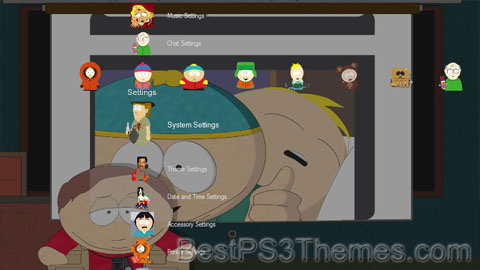
(13 backgrounds)
P3T Unpacker v0.12
Copyright (c) 2007. Anoop Menon
This program unpacks Playstation 3 Theme files (.p3t) so that you can touch-up an existing theme to your likings or use a certain wallpaper from it (as many themes have multiple). But remember, if you use content from another theme and release it, be sure to give credit!
Download for Windows: p3textractor.zip
Instructions:
Download p3textractor.zip from above. Extract the files to a folder with a program such as WinZip or WinRAR. Now there are multiple ways to extract the theme.
The first way is to simply open the p3t file with p3textractor.exe. If you don’t know how to do this, right click the p3t file and select Open With. Alternatively, open the p3t file and it will ask you to select a program to open with. Click Browse and find p3textractor.exe from where you previously extracted it to. It will open CMD and extract the theme to extracted.[filename]. After that, all you need to do for any future p3t files is open them and it will extract.
The second way is very simple. Just drag the p3t file to p3textractor.exe. It will open CMD and extract the theme to extracted.[filename].
For the third way, first put the p3t file you want to extract into the same folder as p3textractor.exe. Open CMD and browse to the folder with p3extractor.exe. Enter the following:
p3textractor filename.p3t [destination path]Replace filename with the name of the p3t file, and replace [destination path] with the name of the folder you want the files to be extracted to. A destination path is not required. By default it will extract to extracted.filename.
Fail theme by toppdogg
Download: Fail.p3t
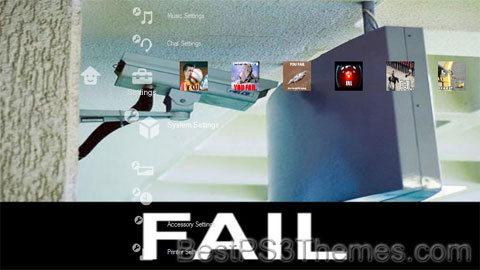
(16 backgrounds)
Redirect to:
Byakuya Kuchiki theme by –Voldo–
Download: ByakuyaKuchiki.p3t
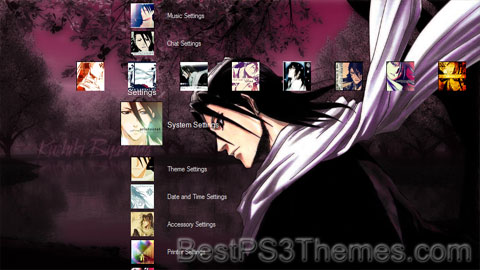
(7 backgrounds HD, 9 SD)
| Byakuya Kuchiki | |
|---|---|
| Bleach character | |
 Byakuya Kuchiki as depicted on the cover for Volume 7 | |
| First appearance | Bleach manga chapter 51 |
| Created by | Tite Kubo |
| Portrayed by | Miyavi |
| Voiced by | Japanese Ryōtarō Okiayu English Dan Woren Greg Chun (live-action film) |
| In-universe information | |
| Family | Soujun Kuchiki (father, deceased) Unnamed mother (deceased) Rukia Kuchiki (sister-in-law, adoptive sister) |
| Spouse | Hisana Kuchiki (wife, deceased) |
| Relatives | Ginrei Kuchiki (grandfather) Renji Abarai (brother-in-law) Ichika Abarai (niece) |
Byakuya Kuchiki (朽木 白哉, Kuchiki Byakuya) is a fictional character in the anime and manga series Bleach created by Tite Kubo. He is a captain of the Sixth Division for Gotei 13 and Rukia's brother. His vice-captain is Renji Abarai.
Byakuya is the 28th head of the noble Kuchiki clan, one of the four great noble families in Soul Society.[1] As such, he acts in an aristocratic manner — he seems always serene and apathetic towards other people, even when he is actually deeply conflicted. He is also extremely calm, even in battle, and is rarely surprised by even the most drastic of actions. At a young age, he is a little joyful, as noted by his grandfather, Ginrei.
He believes in law and order. As the head of one of the great noble families and as a captain in the Gotei 13, he always works hard for a peaceful society. He thinks that if someone in his position does not follow the rules as a good example, then no one will follow them.[2] He believes that to maintain order, all law-breakers must be punished, even if that goes against his own wishes. Despite his icy and regal manner, Byakuya cares for and protects those important to him, even referring to Rukia, his adopted younger sister, as his "pride".
Byakuya is popular among female Soul Reapers and was voted number one in the "captain we desire to release a photo book for" poll taken by the Soul Reaper Women's Association. He likes Japanese cherry blossoms, night-time walks, spicy food, and bananas, but he dislikes sweets.
He wears the standard captain uniform along with a white headpiece called a kenseikan (symbolizing his noble rank as the head of the Kuchiki family) and a white scarf made by the master weaver, Tsujishirō Kuroemon III.[3] The scarf is made from silver-white windflower light silk (ginpaku kazahana no uzuginu) and is a family heirloom handed down through the generations to the head of the Kuchiki family. Forty five houses can be built for the cost of just one such scarf.[1]
Despite his extremely serious personality, Byakuya seems to have a funny side to himself. He not only attends the lieutenants' meeting when Renji is absent, but it is also implied that he attends the meetings of the Soul Reaper Women's Association when Rukia is absent. In the former's case, he reasons that "part of a captain's responsibilities is to make sure the lieutenant's responsibilities are taken care of;"[4] When Renji asks him if he also goes to Rukia's meetings, Byakuya responds only by smiling. On other occasions, Byakuya has jokingly remarked that he uses Senbonzakura to cut his hair[5] and has claimed that life in general is not supposed to be entertaining, and even makes up an idea for a game that is not meant to be amusing.[6] His artistic talent is similar to Rukia's (that is, non-existent); it appears that only Rukia is impressed with his abilities and deeply admires his style.[7] Byakuya prefers formality when he is addressed. He is referred to by title or his full name by everyone except family, his seniors on rare occasions and Ichigo. He initially protested Ichigo calling him by only his first name and has continued to pointedly refer to Ichigo formally as "Kurosaki Ichigo" since instead of reciprocating the casual first-name address.
Little is known about his early history. When his grandfather, Ginrei, was still the captain of the 6th Division, Byakuya plans to take over leadership of the clan, although Ginrei was worried about his rash and hotheaded attitude.[8] During this time Yoruichi Shihouin would play pranks on him and goad him into games of tag using flash steps,[9] which she won every time. Byakuya at this time would very easily lose his temper, and his grandfather believed he would become much stronger if he would learn to control himself. This aspect of his personality is reflected in Senbonzakura when he manifests in the Zanpakutou rebellion arc.
Over fifty years before the main storyline,[10] Byakuya married Hisana, a commoner from Inuzuri, one of the poorest districts of Rukongai; in doing so, he broke the rules by accepting her into the noble Kuchiki family. Shortly before her death from illness, Hisana asked Byakuya to find, adopt, and protect her biological sister, Rukia, whom she had abandoned as a baby. She also made him promise that he would not tell Rukia about her real family. She believed that as she abandoned Rukia when she was younger she was not worthy to be called Rukia's sister, but asked Byakuya to allow her to call him 'brother'.
A year later, during Rukia's time at the academy, Byakuya found her and immediately adopted her into the Kuchiki clan. By adopting her, Byakuya respected his wife's last wish, but had broken the rules of his clan again. He later swore upon his parents' graves that he would never break the rules again, no matter what. As a result, he, though entirely apathetic on the surface, is actually deeply conflicted with the matter of Rukia's execution. Should he intervene, it would require breaking the promise to his parents and the rules again; but should he do nothing he would fail to fulfill the last promise he made to his dying wife to protect Rukia as his own sister.
It is implied that Byakuya became a captain of the 6th division about 50 years before the main Bleach storyline (shortly before Rukia had entered the Gotei 13).[11] Gin Ichimaru became captain of the 3rd Division at the same time, and Gin would commonly start pointless conversations with Byakuya during times they crossed paths.
Byakuya first appears on a mission with his lieutenant, Renji Abarai, to capture Rukia Kuchiki and kill Ichigo Kurosaki. They succeeded in retrieving Rukia, and spared Ichigo, if not for Rukia's intervention, pleading for Byakuya not to give the finishing blow. Byakuya later interrupts Ganju Shiba and Hanatarō Yamada's attempt to rescue Rukia and, later on, Renji's attempt to do the same. he then fights Ichigo for the third time. Following Ichigo's inner hollow's forced submission, both focus their remaining power into one final attack, resulting in a tie. At the end of the battle, Byakuya, through their conversation, realizes that what Ichigo has fought against is the law of Soul Society instead of Byakuya himself, after which he gives his word to protect Rukia.[12] When Sōsuke Aizen orders Gin Ichimaru to kill Rukia, Byakuya intervenes and is overwhelmed by Gin. While being treated, Byakuya tells Rukia why she was adopted, apologizes to her, and thanks Ichigo. Afterwards, Byakuya's attitude toward Rukia changes significantly. He is seen to care for Rukia in an indirect manner and displays a new view on the idea that the law is never perfect.
When the Bounts threatened to harm the Soul Society it becomes serious. He uses the Kuchiki Clan's records to gain information on the Bounts for head captain Yamamoto. Byakuya, aiding Rukia in her battle with Yoshi, attempts to seek out the Bount leader Jin Kariya. The two meet and engage in a battle that is interrupted by Ichigo and later Rantao. In the anime-exclusive Zanpakutō Unknown Tales arc, Byakuya betrays the Soul Society and sides with the rogue Zanpakutō Muramasa, who had set the Soul Reapers' Zanpakutō, including Byakuya's own Senbonzakura, free from their control and was influencing them. He states his reasons for doing so were to maintain his pride; however, it is later revealed that Byakuya's true intentions were to stay close to Muramasa so that he could locate and kill Muramasa's Soul Reaper Kōga Kuchiki for dishonoring the Kuchiki clan.
Byakuya reappears to retrieve Tōshirō Hitsugaya's team on General Yamamoto's order near the end of the Arrancar Arc, but he secretly assigns Rukia and Renji to rescue Orihime. He reasons that he was only ordered to bring them back to Soul Society and that what they chose to do afterwards was none of his concern, though Ichigo and Rukia suspect otherwise. Byakuya appears later in Hueco Mundo to save Rukia from the 7th Espada, Zommari Leroux. Afterwards, he appears with Kenpachi Zaraki to save Ichigo in his fight against the Cero Espada Yammy.
Seventeen months later, Byakuya and several other high-ranking Soul Reapers appear before Ichigo in the human world after Ichigo is robbed of his Fullbring. It is revealed that he and the accompanying Soul Reapers channeled their power into the blade that stabbed Ichigo to restore his lost Soul Reaper powers. Byakuya subsequently fights Shūkurō Tsukishima.
When the Wandenreich invades the Soul Society, Byakuya mourns Lieutenant Chōjirō Sasakibe. Byakuya assists Renji on fighting Stern Ritter F, Äs Nödt. Byakuya activates his Bankai, tells Renji to observe Äs and finds out a way to unseal it after it is sealed. However, Byakuya learns that his Bankai was not sealed, but stolen by the Quincy. Byakuya clashes with Äs, but is easily overwhelmed. Äs Nödt finishes Byakuya off by using his own Bankai against him and smashing him into a nearby wall. When Ichigo breaks free of his imprisonment in the Dangai and arrives at the spot where Byakuya lays wounded, Byakuya asks Ichigo to forgive him for his failure to defeat his enemy and begs him to protect the Soul Society as his dying wish. After the Wandenreich leave, the Royal Guard arrives in the Soul Society, bringing Byakuya with them so that he can be healed. He later returns to the Soul Society sufficiently healed with his strength increased, arriving during Rukia's battle with Äs Nödt. Acknowledging Rukia's growth, he dismisses Äs Nödt's assumption that Byakuya will fight him and instead encourages Rukia to finish Äs Nödt with her own new abilities. After defeating Äs Nödt with her Bankai, Byakuya praises her Bankai but warns her to return to her normal state slowly, commenting on the dangerous nature of her Bankai requiring her to turn her entire body into ice in the process. He subsequently joins Renji, Rukia, and other Soul Reapers to fight against the Wandenreich, tasked with preventing Ichigo from reaching the Soul King's palace. However, the Soul Reapers are overwhelmed by Wandenreich Schutzstaffel Gerard Valkyrie, who grows in size each time he is cut down by the power of "miracles." He orders Rukia and Renji to go join Ichigo at the Soul King's palace, while Byakuya, Toshiro Hitsugaya, and Kenpachi Zaraki continue to try and subdue Gerard Valkyrie.
Ten years later, Byakuya remains the captain of the Sixth Division ten years after Yhwach's apparent destruction and is present during Rukia's promotion as the new captain of the Thirteenth Division. Upon realizing that Yhwach's presence is still lingering in the Soul Society, he elects not to tell Rukia and Renji so that they can visit Ichigo in the human world, and decides to join Mayuri Kurotsuchi and Soifon in disposing of Yhwach's presence. However, they witness the presence abruptly disappear, unaware that Yhwach was dispelled when Yhwach's presence also appeared in the living world and came into contact with Kazui Kurosaki, the son of Ichigo and Orihime Inoue.
As a captain of the Gotei 13, Byakuya is extremely skilled in all forms of Soul Reaper combat. In keeping with his rank, Byakuya's abilities allow him to defeat opponents of captain-level ability without much effort. He holds the Advanced-Captain class within the Gotei 13.
Of particular note is Byakuya's speed: he is skilled in the use of shunpo (Flash steps), having trained with (but never surpassed) Yoruichi Shihōin.[13] Yoruichi also taught Byakuya some techniques of her own creation that involved flash steps, including one called utsusemi (空蝉, lit. Cast-Off Cicada Shell, in reference to their molting), which allows Byakuya to move out of harm's way while leaving an after-image behind. One of Byakuya's favorite techniques, as described by Renji, is Senka (闪花, lit. Flash Blossom), a flash step combined with a spin to quickly move behind the enemy, followed by a combination of two quick thrusts to destroy the opponent's soul chain and soul sleep in one move, destroying the opponent's source of spiritual power.[14] He manages to quickly dispatch Ichigo in their first encounter with this technique. In his battle with Zommari Leroux, he is able to maintain his composure and fight at full speed, despite being forced to cut the tendons in his left leg and arm to prevent Zommari from gaining control of them.
As Byakuya has displayed knowledge of high level kidō spells, and can cast spells up to number 81 without the incantation.[15] He is adept at using them tactically, such as disrupting the movement of Renji's Bankai with a well-timed fire spell and damaging Ichigo's right arm by using a low-level lightning spell at point-blank range to burn a hole through his shoulder.[16]
Byakuya's zanpakutō' is Senbonzakura (千本桜, literally "Thousand cherry blossoms"). Its Shikai is triggered by the command "scatter" (散れ, chire). In the English manga the phrase is translated inconsistently; at the start of volume fourteen it is translated as "die", though later in the same volume "scatter" is used instead. When manifested in the anime Zanpakutō Unknown Tales arc, Senbonzakura resembles a masked man in samurai armor with a half-cherry blossom decoration on his helmet.
In its Shikai, Senbonzakura's blade separates into thousands of slender, petal-like blades. The release may be negated before it is complete, such as when Yoruichi Shihōin wrapped the blade in cloth during Byakuya's short battle with Ichigo. While the blades are too small to be seen by the naked eye, they reflect light in such a way as to appear as cherry blossom petals. he can control the blades at will, thereby allowing him to shred opponents at a distance and break through almost any defense. While Byakuya can control the blades with his mind alone, using his hands allows him to do so more effectively, making the blades move twice as fast.

Byakuya's Bankai, named Senbonzakura Kageyoshi (千本桜景厳, literally "Vibrant Scape of a Thousand Cherry Blossoms"), is essentially a much larger version of Senbonzakura's Shikai. To activate it, Byakuya drops his sword. The sword passes through the ground and two rows of giant blades rise up from the ground. These then scatter into millions of tiny blades. The number of blades is great enough that Byakuya can use them for defense and offense at the same time. He commonly forms them into large masses of blades to crush opponents.[17][18] As with his Shikai, its attack is triggered with the phrase "scatter".
His Bankai has several forms, achieved by arranging the blades in different patterns. They are activated by saying the name of the technique followed by the name of his Bankai. Each form presents a different advantage, such as increasing offense at the expense of defense.
To overwhelm the defense of an opponent, Byakuya can use lit."Pivotal Scape" (吭景, gōkei). This aligns every blade in a spherical formation around his opponent, which then collapses into them from every possible angle, leaving no blind spots and no chance to escape.[19]
His attack form is "Annihilation Scape" (殲景, Senkei), which unites the scattered petals into complete swords that form rows of swords around Byakuya and his opponent. In this form, Byakuya abandons the defense potential of his many blades and concentrates on killing the enemy. While Byakuya can control these swords as he does his regular blades, he usually attacks with just one in hand. He remarks in his battle with Ichigo that he normally only shows Senkei to those he has sworn to "kill by his own hand", Ichigo being the second to see this.[20] After immobilizing an opponent, he can call in the other blades to hit them while they are trapped. He can also use all the blades at once for one immensely powerful strike. He demonstrates that Senkei can also be used as a barrier to protect those inside from a barrage of Cero blasts. He also displays the ability to activate Kageyoshi from inside Senkei, shattering all rows of swords at once.[21]
He also possesses a secret move known as "Annihilation Scape" (一咬千刃花, Ikka Senjinka) which sends all the blades of Senkei towards his enemy at once.
As a final attack he can use "Final Scape" (終景, Shūkei). This condenses every one of his blades into a single sword, drastically increasing its cutting power. The blade appears bright white, and its aura takes the form of a dragon, earning it the name lit."Sword of the White Emperor" (白帝剣, Hakuteiken). Byakuya also grows pure white wings and a halo-like circle in the back, both made of spiritual power.[22]
He was ranked 7th in the most recent popularity poll with 4,010 votes, edging out Orihime Inoue by 35 votes.[23] In 2007, he was one of 4 Bleach characters to place in Newtype's top 100 anime character listing.[citation needed] Dan Woren, Byakuya's English voice actor, liked how his character is able to deal with anything while staying cool. He also noted his need to stick to the rules but found it tragic due to the fact he becomes determined to execute Rukia Kuchiki, his sister.[24]
IGN praises his character's faults and contrasts with Ichigo shown during their climactic battle, stating that "his problem...is that he's arrogant." The battle was "made better by the fact that these two characters have such different personalities, and they really seem to be bringing the best out of each other." His lack of truly villainous characteristics as an antagonistic role was also praised; in the same review, IGN notes that Ichigo and Byakuya are both "just two people fighting for what they think is right. Ichigo for friendship, and Byakuya for honor and Soul Society pride. Instead of the usual evil vs. good battle, it becomes more about whether honor and rules should come first before saving a friend."[25] At the end of the Soul Society arc, moments showing Byakuya's changes in character were heralded as being some of "the best in the episode"; IGN writes "while Byakuya has changed, he still enjoys some of the traditions of the Soul Society."[26]